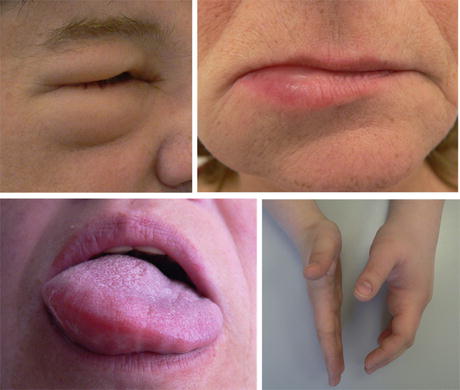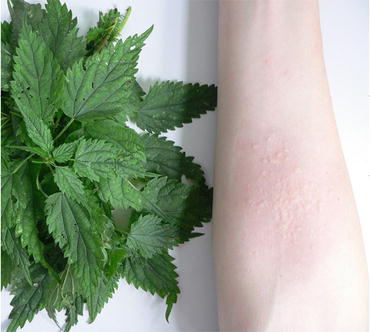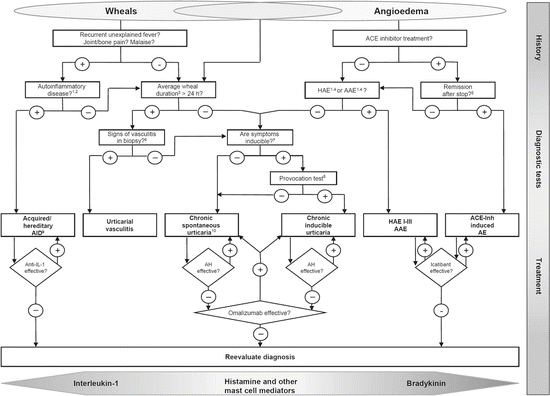Fig. 23.1
Newly developing wheal

Fig. 23.2
Angioedema
23.2 Classification
Urticaria is classified according to (1) its duration and (2) its triggers of exacerbation (Table 23.1). In acute urticaria , the signs and symptoms occur for less than 6 weeks, whereas chronic urticaria is of more than 6 weeks duration [42]. The development of wheals and angioedema in urticaria patients can either be unpredictable and unprompted, in spontaneous urticaria, or it can occur only in response to specific triggers and eliciting situations, in inducible urticarias. In the inducible urticarias, specific triggers, which can be exogenous and acting on the skin directly (physical urticarias, contact urticaria, aquagenic urticaria) or not (cholinergic urticaria), are responsible and required for the induction of signs and symptoms. Triggers of physical urticaria are skin contact with cold and heat (cold urticaria, heat urticaria), mechanical triggers such as friction, pressure and vibration (symptomatic dermographism, pressure urticaria, vibratory urticaria, respectively), or ultraviolet or visible light (solar urticaria) [42]. Triggers of symptoms in contact urticaria are skin contact with urticariogenic substances, and in the case of aquagenic urticaria exposure to water. In cholinergic urticaria, symptoms are brought about by exercise or passive warming (sauna, hot showers, spicy food). Frequently, patients show more than one urticaria type, for example chronic spontaneous urticaria and symptomatic dermographism.
Table 23.1
Classification of urticaria
Acute urticaria | Acute spontaneous urticaria | Spontaneous appearance of wheals, angioedema, or both <6 weeks due to known or unknown causes |
Chronic spontaneous urticaria | Spontaneous appearance of wheals, angioedema, or both ≥6 weeks due to known or unknown causes | |
Chronic urticaria | Chronic inducible urticaria | Physical urticarias |
Symptomatic dermographisma | ||
Cold (contact) urticaria | ||
(Delayed) pressure urticaria | ||
Solar urticaria | ||
Heat (contact) urticaria | ||
Vibratory angioedema | ||
Cholinergic urticaria | ||
Contact urticaria | ||
Aquagenic urticaria |
23.3 Epidemiology
Urticaria is a very common disease and usually of short duration (acute urticaria). Virtually everyone, at one point during his or her life, develops acute urticaria. Most commonly, this is acute contact urticaria, caused by skin contact with urticariogenic substances derived, for example, from stinging nettles or jellyfish (Fig. 23.3). Acute spontaneous urticaria is also very common, and it is estimated that its lifetime prevalence is up to 20 % [25]. Acute spontaneous urticaria rarely progresses to chronic spontaneous urticaria. Nonetheless, chronic spontaneous urticaria, which is thought to be twice as frequent as chronic inducible urticaria, is estimated to have a point prevalence of 0.5–1 % [25]. Chronic spontaneous urticaria can affect all age groups with a peak incidence between the twentieth and the fortieth year of life; that is, patients are primarily affected during important years of their working age [25]. Women are affected about twice as often as men [25].


Fig. 23.3
Contact urticaria induced by stinging nettle
23.4 Pathogenesis
The signs and symptoms of urticaria, both spontaneous and inducible, are due to the activation and degranulation of skin mast cells and the effects of pro-inflammatory mediators released in the process. Mast cells are long-lived resident cutaneous cells that predominantly localize around blood vessels and sensory nerves [26] as well as in the upper papillary dermis. They contain cytoplasmic granules in which preformed mediators are stored that are released into the cell’s vicinity by degranulation in response to activation [36]. These preformed mast cell mediators include histamine , heparin, and proteases (e.g., tryptase, chymase) [7] as well as several cytokines. Upon activation and degranulation, skin mast cells also rapidly produce and secrete prostaglandins, leukotrienes, and platelet activating factor [36]. Mast cells are thought to function as sentinel cells of the skin and a first line of defense against bacteria and other pathogens [27]. The inflammatory effects of their mediators include the activation of sensory skin nerves (itch, burning sensation, pain), the dilatation of skin blood vessels (erythema, hyperthermia) and the induction of plasma extravasation (wheals and angioedema). Histamine plays a critical role in skin mast cell-mediated vasodilation and extravasation, by acting on H1 receptors [8]. The degranulation of skin mast cells in urticaria patients also results in the recruitment of basophils, neutrophils, eosinophils, and other immune cells to the site of activation [41]. The mechanisms of mast cell activation in urticaria are largely unclear. In chronic urticarias, mast cells are typically not activated by the binding of environmental allergens to specific IgE bound to cell surface IgE receptors [42], as is the case in allergies such as allergic rhinitis and anaphylaxis. Reported candidates for relevant signals involved in mast cell activation in chronic spontaneous urticaria include autoantibodies to IgE [11] or the IgE receptor [15], IgE autoantibodies directed against autoantigens (autoallergens) such as thyreoperoxidase [2], complement components such as C5a [10], as well as neuropeptides [4], for example, substance P.
23.5 Clinical Picture
23.5.1 Acute Spontaneous Urticaria
Acute spontaneous urticaria usually resolves within a few days to weeks. Viral infections of the upper airways as well as nonsteroidal antiphlogistics (e.g., ibuprofen, diclofenac, acetylsalicylic acid) and other drugs are common causes. But in many acute spontaneous urticaria patients no relevant cause can be identified. The spectrum of signs and symptoms ranges from a few short-lived wheals to severe angioedema attacks with persistently reoccurring multiple and confluent wheals that affect large body areas.
23.5.2 Chronic Spontaneous Urticaria
The symptoms of chronic spontaneous urticaria are generally the same as in acute spontaneous urticaria, but in contrast, chronic spontaneous urticaria is characterized by a long duration with up to 50 % of patients affected for more than 10 years [35]. The mean length of chronic spontaneous urticaria seems to be around 4–7 years. In up to half of all patients both wheals and angioedema occur, and in about one in ten patients only angioedema develops [25]. The remaining patients solely show wheals. Most patients with moderate or severe disease activity have symptoms every day or almost every day [37]. Disease activity may change markedly over time in the same patient, but the natural course also varies considerably between different subjects.
23.5.3 Chronic Inducible Urticaria
In chronic inducible urticaria , the development of wheals and angioedema is always provoked by the exposure to specific triggers. These conditions are, therefore, more predictable than spontaneous urticaria and disease activity depends on the frequency (and avoidance) of exposure to the relevant trigger at above threshold strength. The sensitivity to symptom-inducing triggers tends to be stable in individual patients over time. Triggers of inducible urticaria include the exposure to low or high temperatures, UV or visible light, as well as pressure and other mechanical forces for the physical urticarias and exposure to urticariogenic substances (contact urticaria), water (aquagenic urticaria), or situations associated with an increase in body temperature (cholinergic urticaria). Skin sites exposed to inducible urticaria triggers such as the hands are therefore more commonly affected. The only exception to this rule is cholinergic urticaria, where triggers (exercise, hot bath, spicy food) do not act directly on the skin but by increasing the body temperature [19]. Similar to chronic spontaneous urticaria, skin lesions in chronic inducible urticaria patients can be accompanied by systemic problems (e.g., hypotension in cold urticaria, malaise in delayed pressure urticaria). These extracutaneous symptoms are thought to be due to the effects of histamine and other pro-inflammatory mediators released at skin sites of trigger exposure and wheal and angioedema development. Chronic inducible urticarias show spontaneous remission in the vast majority of patients, but there are currently no biomarkers or other indicators that allow us to predict, for individual patients, when this will occur. Chronic inducible urticaria usually persists for several years before resolving spontaneously [25].
23.6 Diagnostics
23.6.1 Acute Urticaria
Acute urticaria usually does not require a diagnostic workup, because it is self-limited. The one exception to this rule is suspicion of acute urticaria due to an allergy (i.e., exposure to an allergen in a sensitized patient) or the existence of other eliciting factors such as nonsteroidal antiphlogistics. In this case, allergy tests as well as educating the patients may be useful to allow patients to avoid re-exposure to relevant causing factors.
23.6.2 Chronic Spontaneous Urticaria
The diagnostic workup in patients with chronic spontaneous urticaria should (1) exclude the presence of severe inflammatory conditions, (2) identify the causes in patients with severe and/or longstanding disease, (3) assess disease activity and impact, and (4) exclude differential diagnoses if indicated.
In all patients with chronic spontaneous urticaria, the correct diagnosis should be confirmed by a thorough history, and severe inflammatory conditions should be ruled out by assessing erythrocyte sedimentation rates/C-reactive protein levels and a differential blood count. A physical examination should be performed and all nonsteroidal antiphlogistics should be discontinued and avoided in the future [42].
In patients with long-standing disease and/or high disease activity, underlying causes should be looked for. The search for underlying causes in chronic spontaneous urticaria should be based on clues from the history. Common causes are autoreactivity , autoallergy , chronic infections , and intolerance to food components.
Autoreactivity, that is, a harmful response of the body to itself, is thought to be the relevant cause in one third to half of chronic spontaneous urticaria patients [16]. High disease activity, the development of angioedema, the lack of benefit from antihistamine therapy and autoimmune comorbidities should all prompt the search for autoreactivity.
In addition, most patients with chronic spontaneous urticaria have been found to exhibit IgE antibodies to autoantigen (autoallergens) such as thyreoperoxidase [2] or double-stranded DNA [13], and anti-IgE therapy effectively controls disease activity in these patients [23].
Chronic spontaneous urticaria can also be caused by bacterial infections [42], for example, of the gastrointestinal tract by Helicobacter pylori or chronic ear, nose, or throat infections, especially of the teeth, as well as by parasitic infections and, rarely, viral infections. The spectrum of relevant infections varies across geographical regions [42]. Underlying infections may be asymptomatic or associated with mild symptoms. In many patients no systemic signs of inflammation and infections can be detected. It is, therefore, recommended to investigate patients thoroughly when checking for common chronic spontaneous urticaria causing infections.
Many patients suspect that their chronic spontaneous urticaria is due to what they eat and drink. Whereas food allergies are rarely found to be the cause of chronic spontaneous urticaria [43], many patients exhibit food intolerance [6, 21, 44], for example, to taste intensifiers, preservatives, or to naturally occurring aromatic compounds, biogenic amines, and salicylic acid. Chronic spontaneous urticaria due to food intolerance is confirmed by a documented decrease in disease activity after a 4-week diet that is virtually devoid of potentially relevant food components (sometimes called pseudoallergens) and by an increase in disease activity after oral provocation with these food components. Independent studies found beneficial effects of a pseudoallergen-low diet in one third to three quarters of chronic spontaneous urticaria patients [6, 21, 44].
Less frequent causes of chronic spontaneous urticaria include other chronic inflammatory conditions such as gastritis or inflammation of the bile duct, systemic Lupus erythematosus, and other autoimmune disorders as well as sensitizations to type I allergens (in less than 1 %).
All patients with chronic spontaneous urticaria should be investigated and monitored for their disease activity, disease impact on quality of life, and disease control. The gold standard for measuring disease activity in spontaneous urticaria is the urticaria activity score (UAS) [29]. To obtain UAS values, patients are usually asked to document every day for seven consecutive days (UAS7) the numbers of wheals and the intensity of pruritus they experienced over the last 24 h using a 0–3 point scale for wheals (0 for none, 1 for <20, 2 for 20–50, and 3 for >50) and pruritus (0 for none, 1 for mild: present but not annoying or troublesome, 2 for moderate: troublesome, but does not interfere with normal daily life activity or sleep, and 3 for intense: interferes with normal daily life or sleep). The UAS7 (minimum = 0, maximum = 42) is then calculated as the sum of the daily totals of the wheal and the itch scores. In chronic spontaneous urticaria patients who develop angioedema, but not wheals, the angioedema activity score (AAS) should be used [40] which is also a validated, prospective diary-type instrument assessing the frequency and severity of angioedema symptoms. Patients with wheals and angioedema should be assessed with both scores, the UAS7 and the AAS.
Disease activity and quality of life impairment are poorly correlated in many patients with chronic spontaneous urticaria. Thus, the UAS7 and/or the AAS should be used together with the disease-specific quality of life questionnaires, that is, the CU-Q2oL [3] (for patients with wheals), the AE-QoL [38] (for patients with angioedema), or both (for patients with wheals and angioedema).
The urticaria control test (UCT) is a novel and validated tool for assessing disease control in all patients with chronic urticaria (spontaneous or inducible) [39]. The UCT has only four items and a clearly defined cut-off for patients with “well-controlled” versus “poorly controlled” disease, and it is thus ideally suited for the management of patients in routine clinical practice. An overview on available instruments for patients with chronic urticaria is depicted in Table 23.2.
Table 23.2
Tools for assessing disease activity, disease control, and disease impact on quality of life in patients with chronic urticaria
Chronic spontaneous urticaria | Inducible urticaria | |||
|---|---|---|---|---|
Patients with wheals | Patients with wheals and angioedema | Patients with angioedema | ||
Disease activity | UAS | UAS and AAS | AAS | Determination of trigger threshold with specific provocation test |
Disease control | UCT | UCT | UCT | UCT |
Quality of life | CU-Q2oL | CU-Q2oL and AE-QoL | AE-QoL | No instrument available yet |
Finally, the diagnostic workup in chronic spontaneous urticaria patients should include the consideration of differential diagnoses, especially in patients resistant to standard treatment. Patients with recurrent wheals who do not develop angioedema may have urticaria vasculitis or an autoinflammatory condition such as Schnitzler syndrome or cryopyrin-associated periodic syndromes [17]. Patients with recurrent angioedema who do not develop wheals may have hereditary angioedema or another form of bradykinin -mediated angioedema. A thorough history that includes the right questions and, if indicated, a limited set of investigations is sufficient to confirm or exclude the most common differential diagnoses of chronic spontaneous (and inducible) urticaria (Fig. 23.4) [24].










